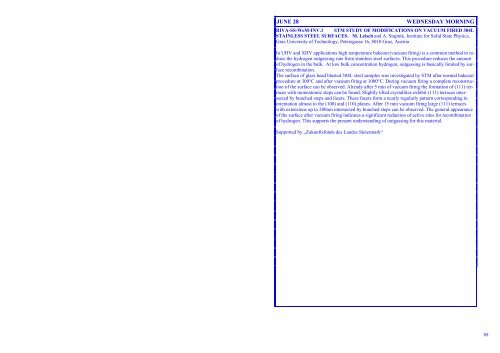Wüest M. 51 Wykes M. 82 Yamaguchi M. 17 Ybarra G. 129 Yubero F ...
Wüest M. 51 Wykes M. 82 Yamaguchi M. 17 Ybarra G. 129 Yubero F ...
Wüest M. 51 Wykes M. 82 Yamaguchi M. 17 Ybarra G. 129 Yubero F ...
Create successful ePaper yourself
Turn your PDF publications into a flip-book with our unique Google optimized e-Paper software.
JUNE 28 WEDNESDAY MORNING<br />
RIVA-SS-WeM-INV.1 STM STUDY OF MODIFICATIONS ON VACUUM FIRED 304L<br />
STAINLESS STEEL SURFACES. M. Leisch and A. Stupnik. Institute for Solid State Physics,<br />
Graz University of Technology, Petersgasse 16, 8010 Graz, Austria<br />
In UHV and XHV applications high temperature bakeout (vacuum firing) is a common method to reduce<br />
the hydrogen outgassing rate from stainless steel surfaces. This procedure reduces the amount<br />
of hydrogen in the bulk. At low bulk concentration hydrogen, outgassing is basically limited by surface<br />
recombination.<br />
The surface of glass bead blasted 304L steel samples was investigated by STM after normal bakeout<br />
procedure at 300°C and after vacuum firing at 1000°C. During vacuum firing a complete reconstruction<br />
of the surface can be observed. Already after 5 min of vacuum firing the formation of (111) terraces<br />
with monoatomic steps can be found. Slightly tilted crystallites exhibit (111) terraces intersected<br />
by bunched steps and facets. These facets form a nearly regularly pattern corresponding in<br />
orientation almost to the (100) and (110) planes. After 15 min vacuum firing large (111) terraces<br />
with extensions up to 200nm intersected by bunched steps can be observed. The general appearance<br />
of the surface after vacuum firing indicates a significant reduction of active sites for recombination<br />
of hydrogen. This supports the present understanding of outgassing for this material.<br />
Supported by „Zukunftsfonds des Landes Steiermark“<br />
88
















